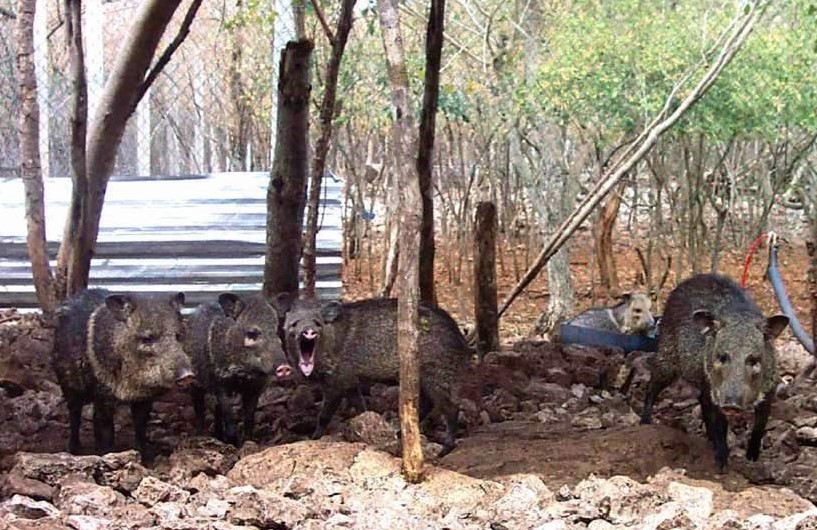Consumption of silages from forage trees by collared peccary Pecari tajacu
Keywords:
silage, native forages, pseudoruminant, collared peccaryAbstract
The Pecari tajacu is considered a pseudo-ruminant, because it can digest vegetable fiber and produce fatty acids in its compound stomach. It has been proven that it consumes the fresh foliage of native trees; however, there is no information on the consumption of silage with chacá (Bursera simaruba), jabín (Piscidia piscipula), moringa (Moringa oleifera) and pixoy (Guazuma ulmifolia). The objective was to evaluate the preference of silage consumption by collared peccary based on moringa, pixoy, jabín and chacá with corn. Four adult male collared peccary specimens with an average weight of 17 ± 1.8 kg were used. Two experiments were carried out in the “Xmatkuil” Wildlife Management and Conservation Unit. In the first, the 4x4 Latin square design was applied for four hours, for four days with four silages. In the second experiment, the test was carried out with three silages using a 3x3 Latin square, the preferred silage from the first experiment was removed. The preferred silage in the first trial was M. oleifera (P<0.05) and B. simaruba in the second (P<0.05). No significant relationship (P>0.05) was found between the nutrient levels and the dry matter intake of the silages.
http://dx.doi.org/10.21929/abavet2022.35
e2022-21
References
AOAC. 2005. Official Method 990.03. Protein (crude) in animal feed, combustion method. Official Methods of Analysis of AOAC International. 18th edition. AOAC International, Arlington, VA, USA. Pp. 30-31, Chapter 4. ISBN: 0935584544 9780935584547. https://law.resource.org/pub/us/cfr/ibr/002/aoac.methods.1.1990.pdf
ANKOM Technology. Sin año. Neutral Detergent Fiber in Feeds - Filter Bag Technique (for A2000 and A2000I). https://www.ankom.com/sites/default/files/document-files/Method_13_NDF_A2000.pdf
CAICEDO W, Pérez M, Sánchez J, Flores A, Duchitanga E. 2019. Contenido de fenoles totales y actividad antioxidante del follaje de anís silvestre (Piper auritum Kunth) y su efecto nutracéutico para cerdos en posdestete. Revista de Investigaciones Veterinarias del Perú. 30(4): 1470-1480. ISSN: 1682-3419.
http://www.scielo.org.pe/scielo.php?pid=S1609-91172019000400008&script=sci_arttext
GALINA-HIDALGO Miguel, Ortiz-Rubio María, Guerreo-Cruz Magdalena. 2018. Estrés oxidativo y antioxidantes. Avances en Investigación Agropecuaria. 22(1): 47-61. ISSN 0188789-0. http://ww.ucol.mx/revaia/pdf/2018/enero/4.pdf
HERNÁNDEZ-ORDUÑO G, Torres-Acosta JFJ, Sandoval-Castro CA, Aguilar-Caballero A, Capetillo-Leal CM, Alonso-Díaz MA. 2012: In cafeteria trials with tannin rich plants, tannins do not modify foliage preference of goats with browsing experience. Ethology Ecology & Evolution. 24:4:332-343. ISSN 0394-9370.
https://www.tandfonline.com/doi/abs/10.1080/03949370.2012.683453
LALL KR, Jones KR, García GW. 2018. Nutrition of Six Selected Neo-Tropical Mammals in Trinidad and Tobago with the Potential for Domestication. Veterinary Science. 5(2):52. ISSN: 2306-7381. https://www.mdpi.com/2306-7381/5/2/52
MAKKAR HPS. 2003. Measurement of Total Phenolics and Tannins Using Folin-Ciocalteu Method. In: Quantification of Tannins in Tree and Shrub Foliage. Springer, Dordrecht. Pp. 49-51. ISBN: 978-94-017-0273-7.
https://link.springer.com/chapter/10.1007/978-94-017-0273-7_3
MÁRDERO S, Nickl E, Schmook B, Schneider L, Rogan J, Christman Z, Lawrenc D. 2012. Sequías en el sur de la península de Yucatán: análisis de la variabilidad anual y estacional de la precipitación. Investigaciones Geográficas. Boletín del Instituto de Geografía, UNAM. 78: 19-33. ISSN 2448-7279.
http://www.scielo.org.mx/scielo.php?script=sci_arttext&pid=S0188-46112012000200003
MARTÍNEZ-FERNÁNDEZ A, Argamentería Gutiérrez A, De la Roza Delgado B. 2014. Manejo de forrajes para ensilar. Servicio Regional de Investigación y Desarrollo Agroalimentaria (SERIDA) del Principado de Asturias, Villaviciosa, Asturias, España. Pp. 282. SBN: 978-84-617-3234-0. http://www.serida.org/pdfs/6079.pdf
MONTES-PEREZ RC, Mora-Camacho O, Mukul-Yerves JM. 2012. Forage intake of the collared peccary (Pecari tajacu). Revista Colombiana de Ciencias Pecuarias. 25:586-591. ISSN 0120-0690. https://www.redalyc.org/pdf/2950/295024922006.pdf
MONTES-PEREZ RC, Borges-Ventura D, Solorio-Sánchez F, Sarmiento-Franco L, Magaña-Monforte J. 2018. Preferencia del consumo de ensilado y su efecto sobre la actividad ovárica del Pecari tajacu. Abanico Veterinario. 8:47-58. ISSN: 2448-6132.
https://www.scielo.org.mx/scielo.php?pid=S2448-61322018000200047&script=sci_abstract
MONTES-PÉREZ R, Canul-Torres C, Cumi-Martín J, Castillo-Caamal J. 2019. Comparación del consumo de especies arbóreas forrajeras por Pecari tajacu en cautiverio. Abanico Veterinario. 9:1-8. ISSN 2448-6132.
http://www.scielo.org.mx/pdf/av/v9/2448-6132-av-9-01-e99-es.pdf
ONTIVEROS Y, Cappa FM, Campos MC, Giannoni SM. 2020. Confirmación de la presencia de pecarí de collar (Pecari tajacu) en el Parque Provincial Ischigualasto (San Juan, República Argentina). Notas sobre mamíferos Sudamericanos. 2:1-6. ISSN 2618-4788. https://www.ojs.sarem.org.ar/index.php/nms/article/view/708/35
ORTEGA-AGUIRRE C, Lemus-Flores C, Bugarín-Prado J, Alejo-Santiago G, Ramos-Quirarte A, Grageola-Núñez O, Bonilla-Cárdenas J. 2015. Características agronómicas, composición bromatológica, digestibilidad y consumo animal en cuatro especies de pastos de los géneros Brachiaria y Panicum. Tropical and Subtropical Agroecosystems. 18: 291 – 301. ISSN: 1870-0462.
https://www.redalyc.org/pdf/939/93944043005.pdf
STATPOINT TECHNOLOGIES, INC 2014. Statgraphics® Centurion XVII. Manual del usuario. https://statgraphics.net/wp-content/uploads/2015/03/Centurion-XVII-Manual-Principal.pdf
YANZA YR, Fitri A, Suwignyo B, Elfahmi, Hidayatik N, Kumalasari NR, Irawan A, Jayanegara A. 2021. The Utilisation of Tannin Extract as a Dietary Additive in Ruminant Nutrition: A Meta-Analysis. Animals. 11 (11): 3317.



